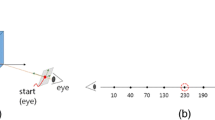Abstract
The shear-warp algorithm with run-length-encoded volume is one of the fastest CPU-based speed acceleration techniques developed so far for direct volume rendering. But it has some defects, such as the increases in memory consumption and preprocessing time as well as the deterioration in image quality. This paper provides two kinds of techniques that can solve such defects without degrading rendering speed. One technique concentrates on enhancing image quality and decreasing memory consumption without reducing rendering speed, by making direct access to the memory space where initially loaded volume data is stored. The other technique concentrates on accelerating rendering speed and decreasing preprocessing time, by creating only one run-length-encoded volume and by combining non-photorealistic rendering techniques with shear-warp algorithm. In the present research, both techniques efficiently decreased the memory consumption and preprocessing time of shear-warp algorithm. They also showed optimal results in rendering speed and image quality.













Similar content being viewed by others
References
Bentoumi H, Gautron P, Bouatouch K (2010) GPU-based volume rendering for medical imagery. Int J Electr Electron Eng 4:1
Busking S, Vilanova A, van Wijk JJ (2008) Particle-based non-photorealistic volume visualization. Vis Comput 24(5):335–346
Cameron G, Undill P (1992) Rendering volumetric medical image data on a SIMD-architecture computer. Proc. of Third Eurographics Workshop on Rendering, pp 135–145
Csébfalvi B, Mroz L, Hauser H, König A, Gröller E (2001) Fast visualization of object contours by non-photorealistic volume rendering. In: Proceedings of Eurographics. Eurographics Association, Aire-la-Ville, pp 452–460
Drebin R, Carpenter L, Hanrahan P (1988) Volume rendering. Comput Graph 22:65.74
Grimm S, Bruckner S, Kanistar A, Gröller E (2004) Memory efficient acceleration structures and techniques for CPU-based volume raycasting of large data. Proceedings of the IEEE Symposium on Volume Visualization and Graphics 2004 (VV’04)
Hiller S, Hellwig H, Deussen O (2003) Beyond stippling—methods for distributing objects on the plane. In: Proceedings of EUROGRAPHICS, pp 515–522
Kaufman A, Cohen D, Yagel R (1993) Volume graphics. IEEE Comput 26:51.64
Krueger J, Westermann R (2003) Acceleration techniques for GPU-based volume rendering. In Proceedings IEEE Visualization
Kye H, Shin B-S, Shin Y-G, Hong H (2005) Shear-rotation-warp volume rendering. Comput Animat Virtual Worlds 16(5):547–557
Lacroute P, Levoy M (1994) Fast volume rendering using a shear-warp factorization of the viewing transformation. In Proceedings of SIGGRAPH, pp. 451–458
Levoy M (1988) Display of surfaces from volume data. IEEE Comput Graph Appl 8(3):29–37
Li Y, Xiao L, Chen S, Tian H, Ruan L, Yu B (2011) Parallel point-multiplication based on the extended basic operations on conic curves over Ring Zn. J Converg 2(1):69–78
Lu A, Morris C, Ebert D, Rheingans P, Hansen C (2002) Non-photorealistic volume rendering using stippling techniques. In Proceedings of IEEE visualization. IEEE Press, Los Alamitos, pp 211–218
Lu A et al (2003) Illustrative interactive stipple rendering. IEEE Trans Vis Comput Graph 9(2):127–138
Malakuti S, Aksit M, Bockisch C (2011) Runtime verification in distributed computing. J Converg 2(1):1–10
Röttger S, Guthe S, Weiskopf D, Ertl T (2003) Smart hardware-accelerated volume rendering. In Procceedings of EG/IEEE TCVG symposium on visualization VisSym, pp 231–238
Sathappan OL, Chitra P, Venkatesh P, Prabhu M (2011) Modified genetic algorithm for multiobjective task scheduling on heterogeneous computing system. Int J Inf Technol Commun Converg 1(2):146-158
Schröder P, Stoll G (2003) Data parallel volume rendering as line drawing. Proc. 1992 Workshop on volume Visualization, pp 25–32
Stegmaier S, Stengert M, Klein T, Ertl T (2005) A simple and flexible volume rendering framework for graphics-hardware-based raycasting. In Proceedings of the International Workshop on Volume Graphics, pp 187–195
Strothotte T, Schlechtweg S (2002) Non-photorealistic computer graphics: modeling, rendering and animation. Morgan Kaufman, San Francisco
Surendran D, Purusothaman T, Balachandar RA (2011) A generic interface for resource aggregation in grid of grids. Int J Inf Technol Commun Converg 1(2):159–172
Sweeney J, Mueller K (2002) Shear-warp deluxe: the shear-warp algorithm revisited. Joint Eurographics—IEEE TCVG Symposium on Visualization, Barcelona, Spain, pp 95–104
Udupa JK, Odhner D (2011) Shell rendering. IEEE Comput Graph Appl 58.67
Westover L (1990) “Footprint evaluation for volume rendering”, In ACM SIGGRAPH Computer Graphics 24(4):367–376
Yagel R, Kaufman A (2011) Template-based volume viewing. Eurographics 92, Cambridge, UK, pp C-153-167
Zuiderveld, KJ, Koning AHJ, Viergever MA (2011) Acceleration of ray-casting using 3D distance Transforms. In Proceedings of visualization in biomedical computing. Chapel Hill, North Carolina, pp 324–335
Acknowledgment
This research was supported by MKE(Ministry of Knowledge Economy), Korea, under the ITRC(Information Technology Research Center) support program supervised by the NIPA(National IT Industry Promotion Agency) (NIPA-2010-C1090-1001-0008), Future-based Technology Development Program through the National Research Foundation of Korea(NRF) funded by the Ministry of Education, Science and Technology(2010-0020-732), a Brain Korea 21 project and a grant of Korea University.
Author information
Authors and Affiliations
Corresponding author
Rights and permissions
About this article
Cite this article
Choi, K., Jo, S., Lee, H. et al. CPU-based speed acceleration techniques for shear warp volume rendering. Multimed Tools Appl 64, 309–329 (2013). https://doi.org/10.1007/s11042-012-1010-7
Published:
Issue Date:
DOI: https://doi.org/10.1007/s11042-012-1010-7




